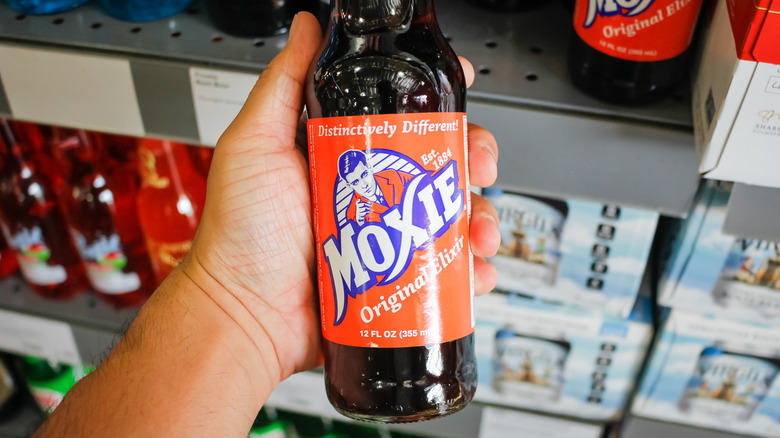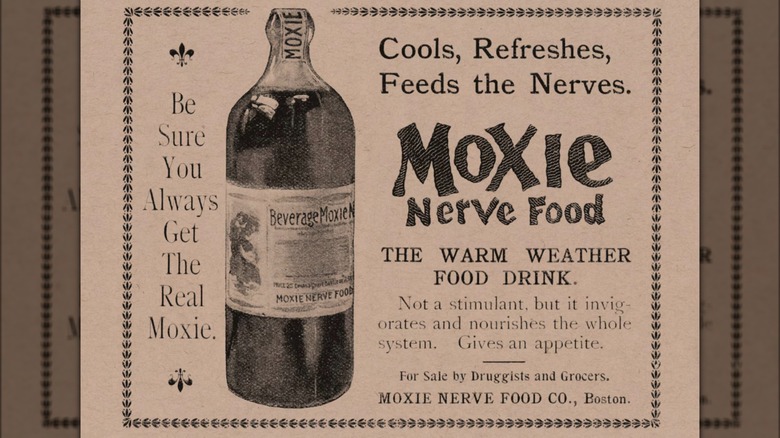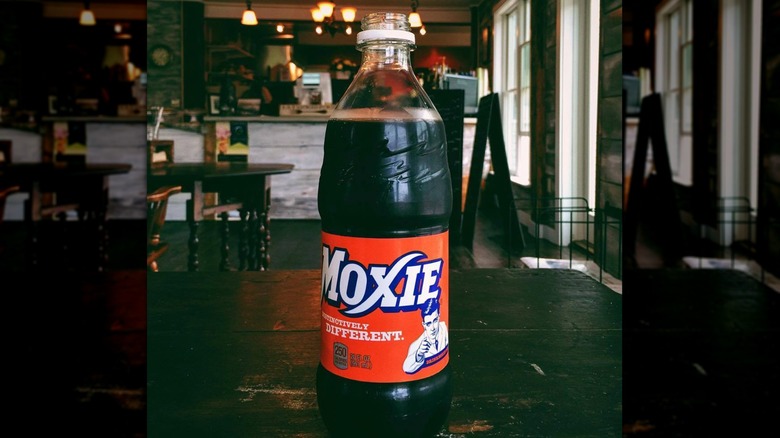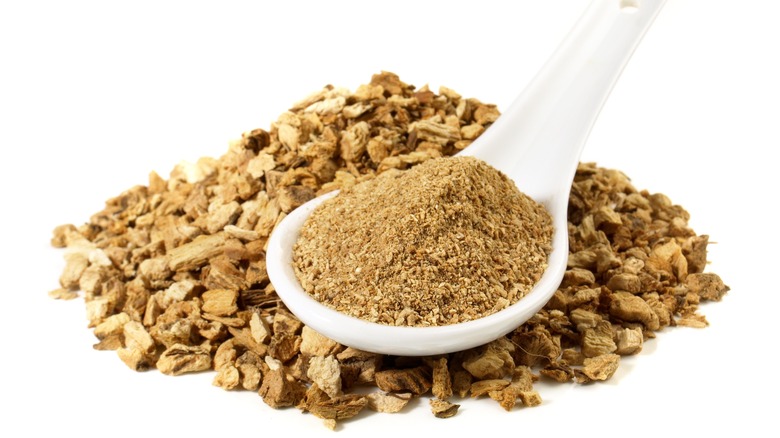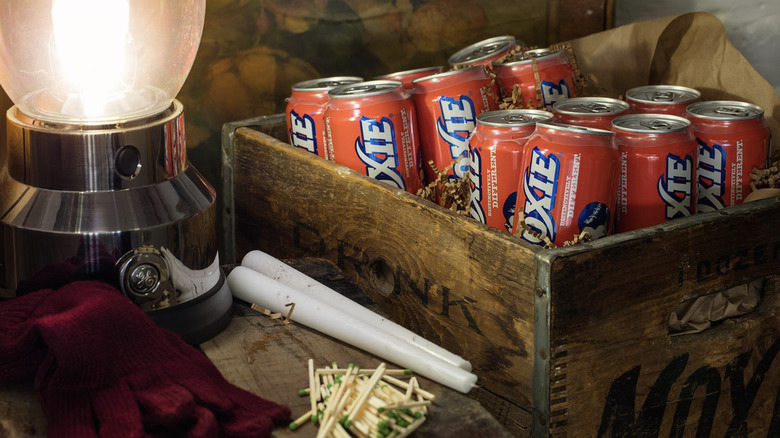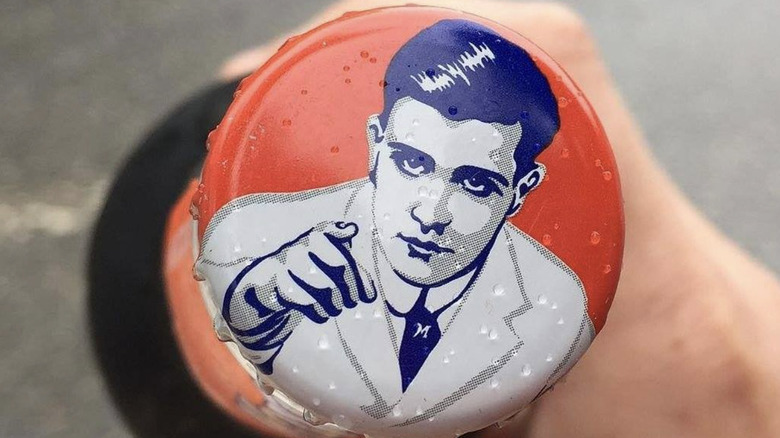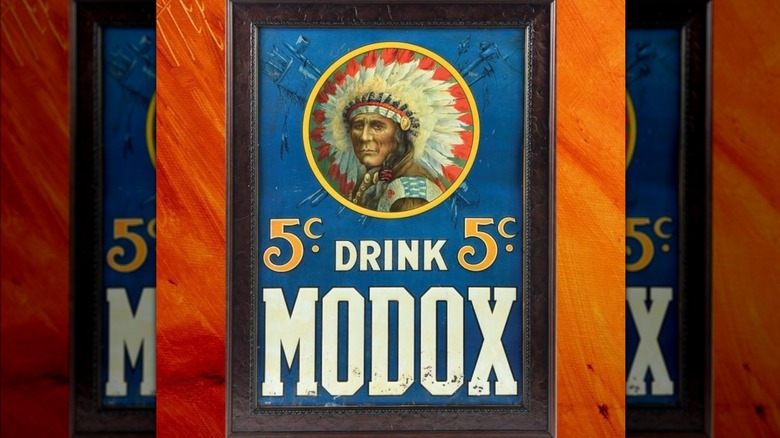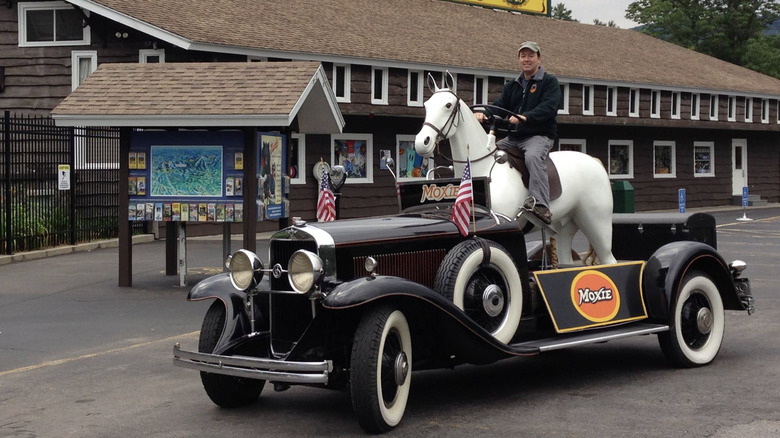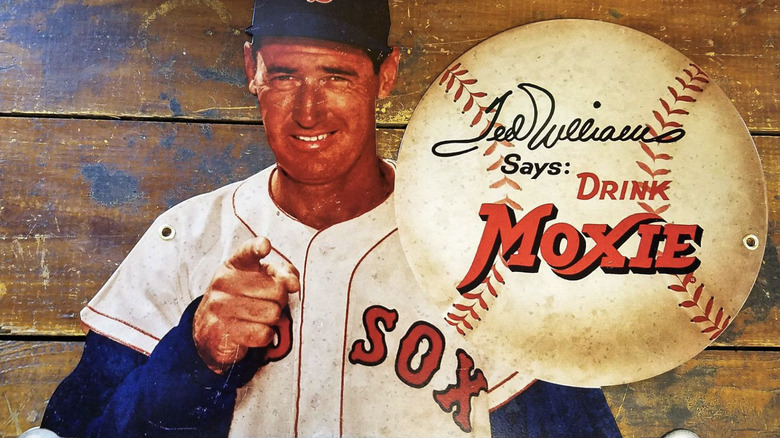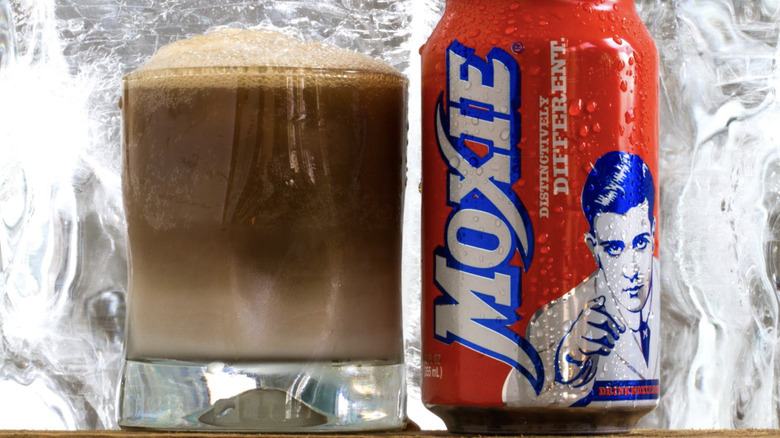The Untold History Of Moxie
Described as "an acquired taste" and "distinctively different," Moxie isn't your average sugary-sweet pop. The soft drink's unique herbal, slightly bitter flavor stems from gentian root, a botanical typically used to make cocktail bitters, such as Regan's and Angostura. At one stage, Moxie's advertising tagline was even "Learn to Drink Moxie." Perhaps Rebecca Orchant from HuffPost summed up Moxie's taste best when she called it polarizing, adding, "Moxie lovers are just slightly less effusive than Moxie haters. We're pretty sure we've never met anyone who thinks this oddly bittersweet soda is 'just okay.'"
Invented in 1876, Moxie was the first mass-produced soft drink in the U.S. In fact, the beverage predates Coca-Cola by a decade and, at one point, even surpassed the iconic beverage in sales. Moxie's popularity declined during the Great Depression after the company drastically scaled down advertising. Meanwhile, Coca-Cola took the opposite trajectory and flourished.
Today, Moxie still enjoys a loyal following in New England where it's the official soft drink of the state of Maine, but lacks the same level of recognition in other regions of the country. The soda brand manages to sell approximately one million cases annually, which pales in comparison to Coca-Cola's billions of cases sold worldwide. Interestingly, in 2018, the Coca-Cola Company acquired Moxie with the intention of introducing it to a broader audience.
Ready to find out more about the fascinating history of this long-lived pop brand? Let's delve in.
Moxie was initially marketed as a medicinal tonic
Before there was Moxie, the soft drink, there was "Moxie Nerve Food," a cure-all medicinal tonic. Invented by Dr. Augustin Thompson in Lowell, Massachusetts in 1876, the syrup was touted as free of the typical health tonic ingredients of the time – cocaine and alcohol. Interestingly, there have been speculations suggesting that Moxie's secret ingredient was, in fact, cocaine. Nevertheless, Thompson firmly insisted that Moxie was as "harmless as milk." And according to the good doctor, the syrup was a true miracle, curing nervous exhaustion, paralysis, alcoholism, blindness, headaches, sexual dysfunction in men, and the "softening of the brain."
A Civil War veteran and physician, Thompson boasted a stellar reputation and his invention gained rapid popularity. Originally marketed as a "nostrum," Moxie was deemed more potent than typical tonics and had to be administered one spoonful at a time. In 1884, the restorative tonic underwent a transformation and became a carbonated soft drink.
Moxie was the first bottled pop produced in the U.S.
Moxie in its soft drink form, which contained both a concentrate and carbonated water, hit the shelves in 1884, making it the first bottled carbonated pop manufactured in the U.S. Pitched as an energizing cure-all, Moxie sold five million bottles in its first 12 months on the market. Following the enactment of the Pure Food and Drug Act in 1906, which regulated the food and drug industries and the language that could be used to promote products, Thompson shortened the company's name from "Moxie Nerve Food" to just plain "Moxie."
With this transformation, Moxie was repurposed from a medicinal tonic to a beverage "for people of discerning tastes." To promote Moxie's newfound image as a soda, the brand's marketing team had to come up with new promotional strategies. One of these was a 32-foot Moxie bottle constructed for the New England Food Fair in 1906. Today, the giant Moxie bottle can be found at the Matthews Museum of Maine Heritage.
Moxie's ingredients have changed over time
Perhaps to add to Moxie's mystique, Thompson initially claimed that the tonic was produced from a rare plant he came across during his sojourns in South America. The bitter ingredient in Moxie was later identified as gentian root, a common botanical used in potions since 170 B.C. The root is said to aid digestion and settle the stomach, hence the medicinal claims associated with Moxie after it was first developed.
According to a 1903 book, "The Secrets of the Specialists" by Dr. Dale Covey, Moxie's first recipe also contained oats, wintergreen, and sassafras. There's also an old Moxie label that details the ingredients as sugar, cinchona, alkaloids, caramel, and flavoring. Irrespective of the precise composition, sassafras would have had to be removed from Moxie's recipe after it was banned by the FDA in the 1960s due to its suspected carcinogenic properties.
While its ingredients may have changed, Moxie's taste has stayed remarkably consistent over the years, with one notable exception. Concerned about Moxie's declining popularity, in 1968, the Moxie company made the decision to sweeten the soft drink. The move failed to attract new converts and angered the beverage's devoted fans. In 1980, Moxie's formula was restored to its pre-1968 form. However, today, it uses high-fructose syrup rather than sugar.
The origins of the term Moxie are uncertain
Moxie the drink is credited with giving rise to the term "moxie," which denotes "force of character, determination, or nerve," as stated on the Moxie website. So how did this come about and where did the term originate in the first place? While Thompson claimed that he named the soft drink in honor of Lieutenant Moxie who discovered the gentian root, this is likely just a tall tale. In fact, it's unlikely that Lieutenant Moxie ever existed since his name couldn't be found in Civil War records. Some have suggested that the term moxie is an adaptation of the Indian word "maski," which translates to medicine.
While stories abound, it's most likely that the name of the uniquely flavored beverage was inspired by a Native American term that means "dark water." It's plausible that Thompson encountered this term due to its prevalence in the names of many of Maine's landmarks. Some of these include Moxie Pond, Moxie Lake, Moxie Reef, Moxie Mountain, and Moxie Falls.
The Moxie Man first appeared in 1906
The Moxie Man — an image of a man pointing a finger at the consumer "Uncle Sam" style — has been a part of the drink's advertising campaign since 1906. However, the picture of the Moxie Man as depicted on the beverage's label today dates back to 1911. While the logo was changed in 2010, it was reinstated a year later due to complaints from customers.
While some asserted that the Moxie Man was modeled on the company's head of advertising, Frank M. Archer, this is impossible since Archer would have been around 50 when Moxie Man first made his debut. In fact, in 1922, Archer stated, "In almost every town and city in the United States there is someone who believes they know the original of the Moxie Boy. In view of the many thousands of different opinions on this subject, we may offer a prize to the person who picks the actual boy, furnishing us photographic proofs" (via Popular Timelines). While this theory can't be confirmed or refuted, according to The Moxie Congress, the Moxie Man was probably John T. Chamberlain of Revere, a model used by lithographers at the time.
Moxie won a lawsuit against an alleged copycat
In 1907, the Moxie Nerve Food Company sued the Modox Company, a beverage manufacturer behind a beverage line billed as "The New Nerve Drink." The lawsuit, filed in Boston, alleged that Modox's resemblance to Moxie — both in terms of name and ingredients — was too close for comfort. Although the Boston lawsuit was dismissed, the Moxie Nerve Food Company later won a similar case against Modox in New York, effectively pushing it out of business.
According to Drinkmodox.com, Modox was a Rhode Island-based company that distributed the soft drink around Providence by horse and cart. Moxie, which wanted to expand its distribution to the area, tried to acquire Modox from its founder and operator, James Stephen Barry or "Big Jim." When he refused to sell his company, Moxie sued Modox to put Big Jim out of business. After Modox's demise, Big Jim went on to create another soft drink called HERB-O PHOSA but ultimately failed to make it a success.
Moxie Horsemobiles were a thing
In 1886, Moxie started using horse delivery wagons that carried large replicas of the soft drink bottle to both advertise and distribute the beverage. By 1905, the company had adopted automobiles for marketing its drinks, which was revolutionary at the time. It wasn't long before Moxie began advertising its drinks to drivers as a safe alternative to alcohol since some modern tipplers could no longer rely on their horses to bring them home after a night out at the local bar.
The Moxie Horsemobile, which was developed in 1918, took things a step further. The unique fleet of vehicles featured a horse statue mounted on a car. The driver would mount the horse to steer the car. The Horsemobile was used in parades and many other public events to promote Moxie. In later years, even such prestigious vehicles as the 1931 LaSalle and Buick Series K were converted into Horsemobiles. Notably, in 2011, a 1935 Rolls-Royce Moxie Horsemobile was auctioned for $50,000, while in 2021, a 1929 Ford Model "A" Moxie Horsemobile fetched more than $60,000 in a sale.
Moxie was big on endorsements
Moxie was no stranger to using big-name endorsements to capitalize on the influence and credibility of well-known individuals. The Boston Red Sox pitchman legend, Ted Williams, appeared in several Moxie magazine ads in the 1950s. President Calvin Coolidge is said to have marked his 1923 inauguration by buying a Moxie at a local Plymouth Notch general store. In a similar fashion, the American writer, E.B. White, once wrote, "Moxie contains gentian root, which is the path to the good life." Whether this was orchestrated by the soda brand isn't clear.
Moxie even attempted to leverage the popularity of President Teddy Roosevelt in its advertising, portraying him next to the words, "The Leading Exponent of the Strenuous Life," and a bottle of Moxie described as "The Necessary Support of the Strenuous Life." In 1903, the president voiced his disapproval of the campaign, forcing the soda-pop brand to discontinue the questionable campaign.
There is a Moxie Festival in Maine
Maine's fondness for Moxie extends far back, likely because it happens to be the birthplace of its inventor. As such, it's little surprise that the New England state has been hosting the Moxie Day Festival since 1984 and has even named the beverage its official state soft drink in 2005.
Each year, on the second Saturday of July, tens of thousands of Moxie enthusiasts from across the U.S. descend on the village of Lisbon Falls to celebrate the beloved beverage. Started by a local fruit store owner and a Moxie fan, Frank Anicetti, the festival sees the town's streets turn orange with Moxie shirts. There's also a parade, floats, live bands, and cook-offs that involve the beverage. In 2023, the Moxie Festival promises "Three Days of Peace, Love & Moxie" with vendors, food, and music. This year's event has a '60s or '70s theme, inviting participants to don their finest retro attire and enjoy a Woodstock-style concert.
